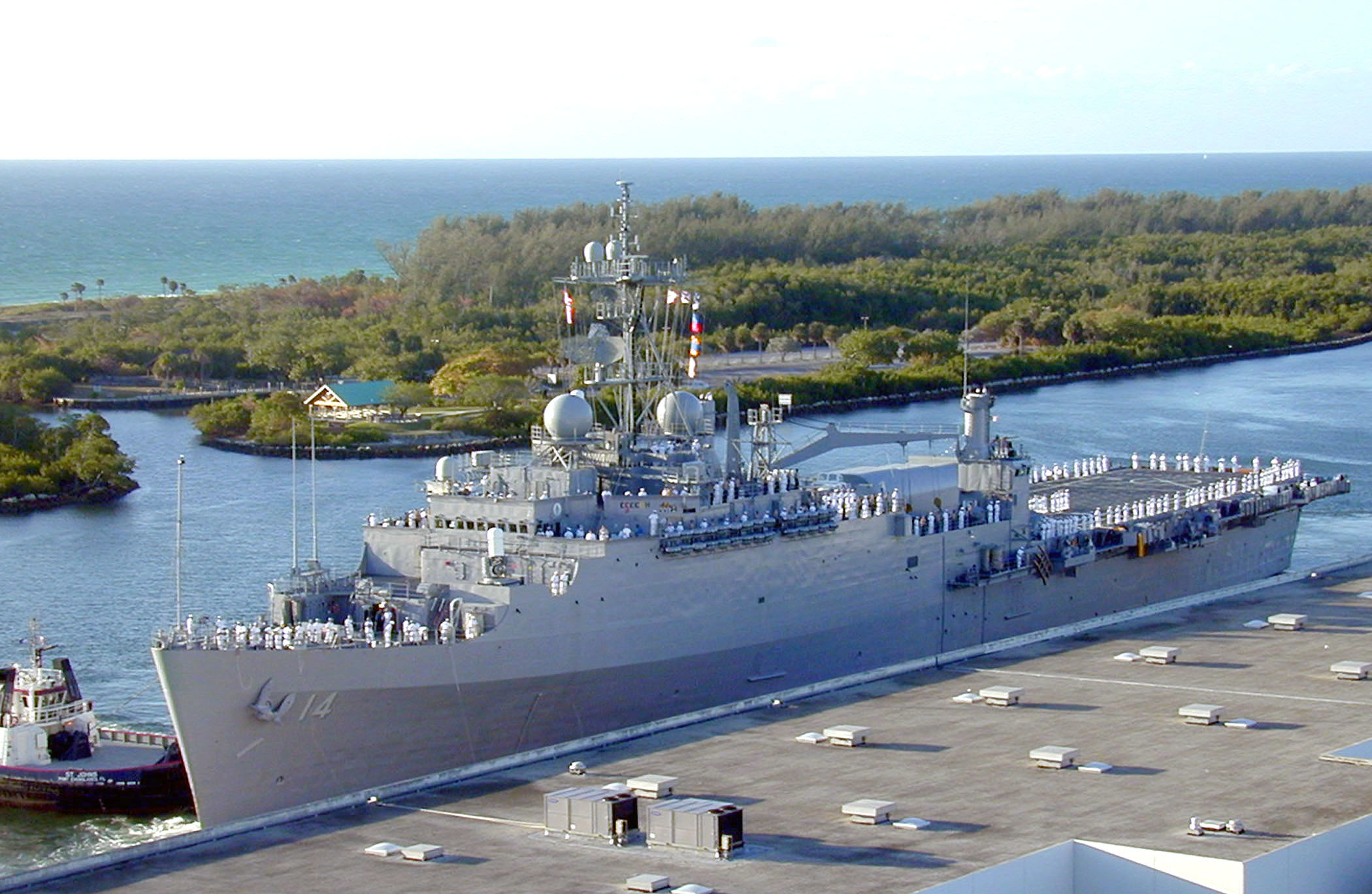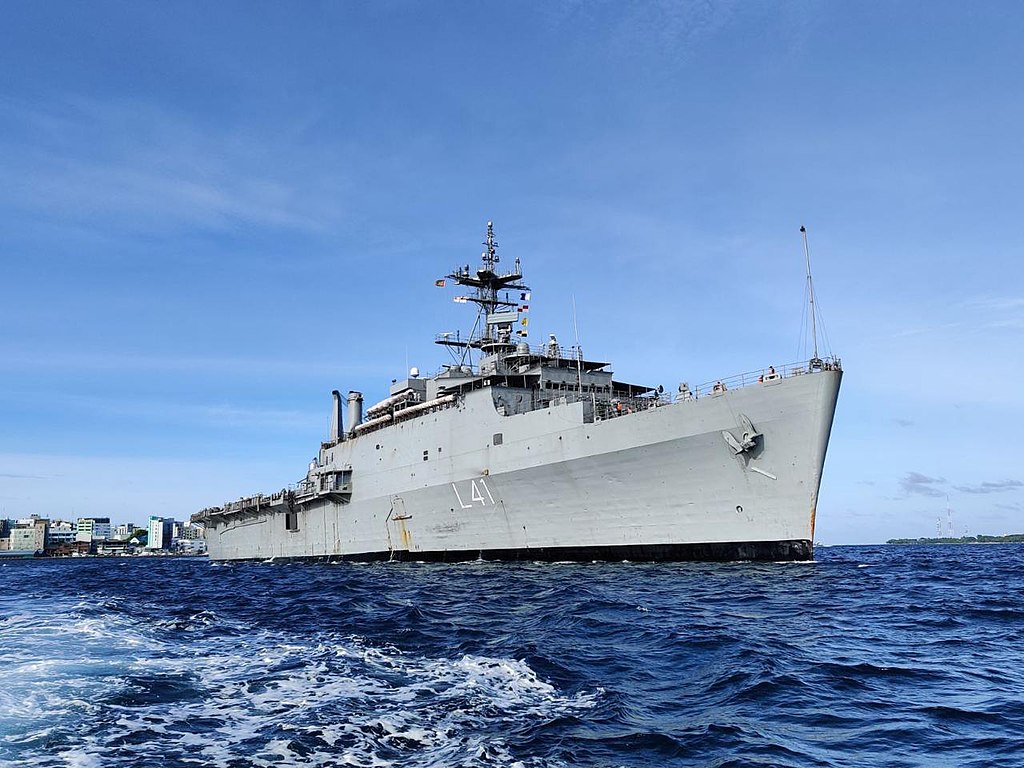The Indian Navy has started an exercise with the US Navy on the Eastern Seaboard. Amphibious operations are a big part of the drills.
The drills have once more highlighted that the Indian Navy operates only one Landing Platform Dock, imported from the US in 2007, and its proposal to get more LPDs is over a decade old.
The LPD in the Indian Navy’s fleet INS Jalashwa (the former USS Trenton) is an Austin-class amphibious transport dock that has a sealift capability for over 3500 troops and a squadron of armored vehicles. INS Jalashwa was added to the Indian Navy’s inventory after the Tsunami in 2004.
When one of the largest humanitarian missions was launched in the wake of the natural disaster in 2004, it highlighted a major shortcoming of the force, considered to be the first responder in the Indian Ocean Region (IOR)—it did not have amphibious assault ships (LPDs), which help move men and materials.
When these LPDs were not carrying helicopters, tanks, and troops for landing at the enemy’s coasts, they carried humanitarian aid and acted as floating hospitals. The Indian Navy has issued the request for proposals twice since 2004 – once in 2011 and another one in 2021. The 2011 proposal could not be fructified owing to accounting problems between Indian and foreign designers.

In 2013 the Navy issued the tender but in 2020 scrapped the tender as the Indian Navy’s requirements for the LPDs had changed. The wheels for procuring 4 more LPDs were again set in motion once more in 2021.
The RFI issued in 2021 sought LPDs with a maximum length of around 200 meters and capable of ferrying 900 troops. Unlike the western LPDs, which have little offensive armament onboard, the Indian Navy envisaged deploying 16 surface-to-surface missiles.
The ship should also have 32 short-range surface-to-air missiles and be able to replace the fast-firing guns with ‘directed energy weapons’, namely lasers and microwaves that can fry the guidance seekers of missiles and UAVs.
The LPDs should be able to carry at least 6 main battle tanks and roughly 60 heavy trucks. These vehicles would be ferried to the shore in a smaller amphibious craft that will be deployed from an LPD dock. Besides this, the LPD will have 14 helicopters (two heavy-lift choppers and 12 ‘special operations’ rotary aircraft). The special operations helicopters would carry troops and light cargo to battlefields.
Considering futuristic warfare, these LPDs will be able to deploy unmanned vehicles, both aerial and underwater.
The Indian Navy’s intended LPD needs to be capable of “transporting and landing a combined arms force and sustaining their operations ashore.” These warships will be able to sustain a body of troops for prolonged durations and carry on board a full range of combat cargo required for undertaking and sustaining the operations ashore.
LPDs will undertake out-of-area contingencies (OOAC) through their inherent capability to transport and deploy forces ashore, arrive quickly in the area, and sustain operations at sea for prolonged durations. These vessels will also act as Command Centres for the Amphibious Task Force Commander, Landing Force Commander, and Air Force Commander.
In peacetime, it will also undertake Humanitarian Assistance and Disaster Relief Missions. The LPDs will also provide medical facilities for the treatment of battle casualties.
According to the RFI, the first of the four LPDs was expected to be delivered in a maximum of 60 months, followed by delivery of one vessel every 12 months. Considering the tender is still far away from being awarded, India’s amphibious capability will continue to have a big gap.
Importance Of Amphibious Ops
The importance of amphibious landings has been underscored since the D-Day landings at Normandy, France, and the Pacific Island campaign in World War II. It is more relevant today in the Indo-Pacific region.
The Indo-Pacific is a region of contested territorial and maritime claims; hence, amphibious platforms are important for deploying and sustaining troops far away. In the region with many island countries, amphibious platforms also play a pivotal role in humanitarian assistance and disaster relief.

The Indo-Pacific is a peculiar geography comprising vast swathes of deep open ocean to relatively shallow and congested archipelagic choke points like the Malacca Straits and the South China Sea.
Also, the Chinese anti-access/area denial strategy around its reclaimed islands in international waters in the South China Sea makes it imperative for the regional navies to invest in ‘green water’ capabilities that help them operate closer to shore.
Recognizing it, the US Marine Corps and the US Navy have made amphibious capabilities a key aspect of the US forward-deployment strategy in the Indo-Pacific.
China has continued to strengthen its amphibious capabilities with its Type 071 amphibious assault ships (LPDs). With a displacement of nearly 20,000 tons, these vessels are larger than the US Navy’s San Antonio LPD-17 class ships. These vessels serve as the backbone of China’s future amphibious fleet. They can carry troops, armored vehicles, helicopters, and landing craft.
Beijing has already embarked on the construction of the Type 075 variant vessel. The three of these warships are expected to be commissioned by 2025. The Type 075 will give the PLA-Navy greater capacity and endurance for long-range operations.
The Type 075, being constructed at the Hudong-Zhonghua shipyards, will provide amphibious power projection, sea control, and amphibious air support capability with a helicopter complement and command and control capabilities. It will have a displacement of between 30,000-40,000 tons. Its floodable well-dock is capable of supporting both Russian and Chinese-designed landing craft air cushions (LCAC).
The futuristic Type 076 vessels are expected to be equipped with electromagnetic catapults, which would enhance their ability to support fixed-wing aircraft, making them more like aircraft carriers.
- Ritu Sharma has been a journalist for over a decade, writing on defense, foreign affairs, and nuclear technology.
- The author can be reached at ritu.sharma (at) mail.com
- Follow EurAsian Times on Google News




